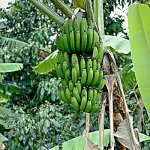

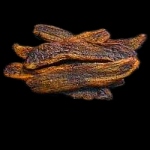
-4-hepten-2-yl_acetate_plus.gif)
isoamyl acetate, 4(Z)-hepten-2-yl acetate,
ethyl cinnamate and dimethyl-hydroxyfuranone
Musa paradisiaca ssp. sapientum (Musaceae) Common banana, Pisang
There are about 60 species of banana. Domesticated species don't need pollination and are without seeds. The wild species are pollinated by bats and have pea-sized, rugged seeds.
Banana is grown on a large scale worldwide. Brazil alone produces about 6 million tonnes a year, of which less than the half is exported.
As most people know, the conditions during transport of bananas must be carefully controlled so that ripening is prevented. Compared with most other fruits, banana ripens violently. The peel becomes yellow, brown spots will progressively appear, and the flesh changes consistency and aroma. Its respiration, measured as oxygen-uptake per weight, is one of the highest among fruits. This is the reason why banana wasn't seen in Europe until 1882, arriving at England on a ship from the Canary Islands.
The well known and characteristic aroma from green or slightly ripe bananas is dominated by lower aliphatic alcohols and their esters, e.g. isoamyl acetate and 4(Z)-hepten-2-yl acetate. As ripening develops, the aroma becomes milder, sweeter and fuller, with the appearance of phenol ethers, e.g. eugenol and elemicin. By sun drying (or by oven) the aroma is further intensified. It gets a rich, caramellic and deep-fruity sweetness. At this stage, 2,5-dimethyl-4-hydroxy-3[2H]-furanone, also known from strawberry, and ethyl cinnamate becomes important (freeze-dried banana chips don't get this character) [26].
In the tropics, two other bananas are much grown, Musa paradisiaca (subsp.) normalis, which is very starchy, and M. textilis, from which 'Manila hemp' is being processed.
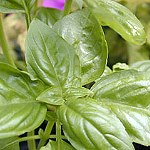
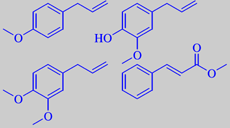
estragol, eugenol, methyleugenol and methyl cinnamate
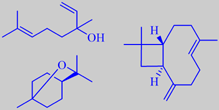
linalool, 1,8-cineole and caryophyllene
Ocimum basilicum (Labiatae) Mediterranean basil, Sweet basil
In Denmark, basil means Mediterranean basil with its characteristically vaulted leaves, but globally there are more than 60 species and an even higher number of sorts having vastly different aromas (anis-like, cinnamon-like, camphor-like, lemon-like, etc.). Recently, the African basil, O. kilimandscharicum, was tentatively introduced on the European market, but its flavour is rather sharp and perhaps less immediately pleasant.
Basil must be used freshly cut, its lively spicy aroma is easily lost. The leaves contain < 1 % essential oil of variable composition. Major constituents are linalool and methylchavicol (estragol) together with eugenol, methyleugenol, methyl cinnamate, 1,8-cineole, caryophyllene, etc. [38].
Etymology: Lat. Ocimum, from Gr. ozein, smelling (ref. ozone); Gr. basileus, king. In France basil is called
herbe royal.
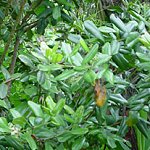
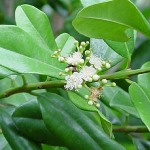
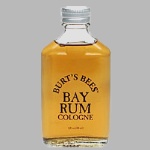

chavicol, eugenol and myrcene
Bay leaf
Pimenta racemosa (Myrtaceae)
The middle-sized bay tree has been grown in the West Indies since old
ages. Bay leaf oil is obtained by steam distillation of the leaves, often
followed by a removal of terpenes by vacuum distillation. It has a highly
characteristic, warm, sweet phenolic-spicy odour and a mildly antiseptic
effect. It is used as a component in masculine perfumes, e.g. Old Spice
(Shulton 1938), and, dissolved in alcoholic water, as a hair tonic, the
so-called Bay Rum. Its main ingredients are chavicol, eugenol and myrcene
[6].
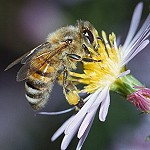


phenylacetic acid and methyl phenylacetate,
the latter being found, for example, in privet flowers [12]
Apis mellifera (Apidae) Honeybee
One of the specific flavour notes often attributed to honey is caused by the aromatic compound phenylacetic acid and its lower esters. These odorants are very powerful and rather unpleasant in their pure state. They can be smelled from the beeswax too, but here they are usually so well integrated with a multitude of mild and tenacious odorants that the fragrance becomes attractive for parfumeurs (depending on the flowers visited by the bees). A so-called beeswax absolute is produced on a limited scale by extraction of the beeswax with ethanol followed by evaporation, yielding around 1 % of absolute useful for creating honeyed flower nuances in luxury perfumes.
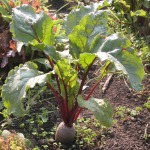
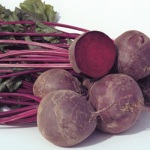

geosmin
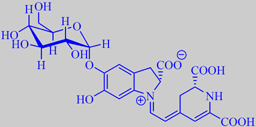
betanin
Beta vulgaris ssp. vulgaris var. rubra (Chenopodiaceae) Red beet, Garden beet
All beets are grouped in one species, Beta vulgaris, which is then divided into several subspecies. Several cultivars are valued - as root vegetables, fodder, or sugar-beets.
Beetroot is eaten boiled, steamed or baked, either warm, e.g. with butter as a delicacy, or cold, mostly pickled, as a condiment. In Eastern Europe the beetroot soup called borscht is a popular dish. The deep red colour of beetroot is due to betacyanin pigments, e.g. the glycoside betanin.
The characteristic earthy or mouldy flavour of beetroot is due to geosmin. It has been disputed whether geosmin is produced by the beetroot itself, or whether it is produced by symbiotic soil microbes living in the plant. However Lu et al. at Washington State University, USA, grew sterilized beetroot seeds aseptically and found geosmin in the seedlings, supporting the conclusion that beetroot is capable of endogenous synthesis of geosmin [188].
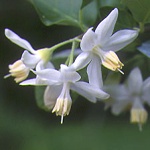
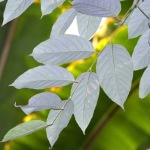
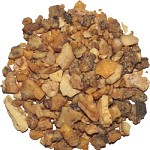
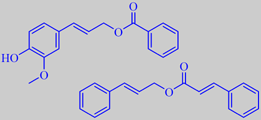
coniferyl benzoate and cinnamyl cinnamate
Styrax benzoin, S. tonkinensis (Styracaceae) Benzoin
Benzoe or benzoin gum is a balsam obtained from trees of the genus Styrax and produced mainly in Asiatic countries such as Indonesia, Sumatra, Java, Laos, Thailand and Vietnam. Two varieties of benzoin gums exist in the trade: benzoin gum Siam from S. tonkinensis and benzoin gum Sumatra from S. benzoin. The balsam is obtained from cuts in the bark.
Benzoin gum siam has a pleasant, sweet-balsamic odour with a distinct note of vanilla, whereas benzoin gum Sumatra has a strong odour influenced by styrene. They are both used in flavours and fragrances.
Benzoin gum Siam is essentially composed of coniferyl benzoate (65-75 %), p-coumaryl benzoate (10-15 %), cinnamyl cinnamate (styracine) (0.5-6%) , benzoic acid (12 %), siaresinolic acid (6 %) and vanillin (0.3 %).
Cinnamyl cinnamate has a mild, soft and very tenacious balsamic-floral odour. However, the odour of the balsam is influenced by minor amounts of volatile constituents like benzaldehyde and methyl benzoate. Benzoin gum Sumatra is richer in cinnamates, cinnamic acid and styrene [39] [75].
Etymology: Lat. styrax, fragrant resin. Benzoe is behind the names benzoic acid, benzaldehyde, benzene, etc. (see also styrax and tolu balsam).